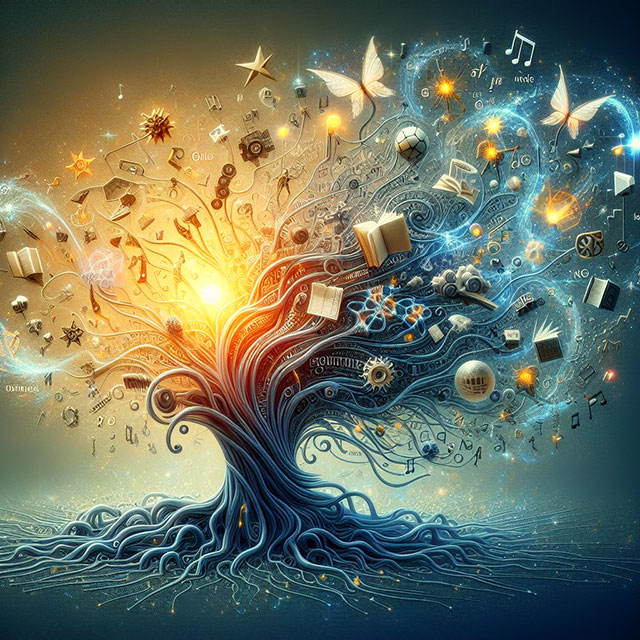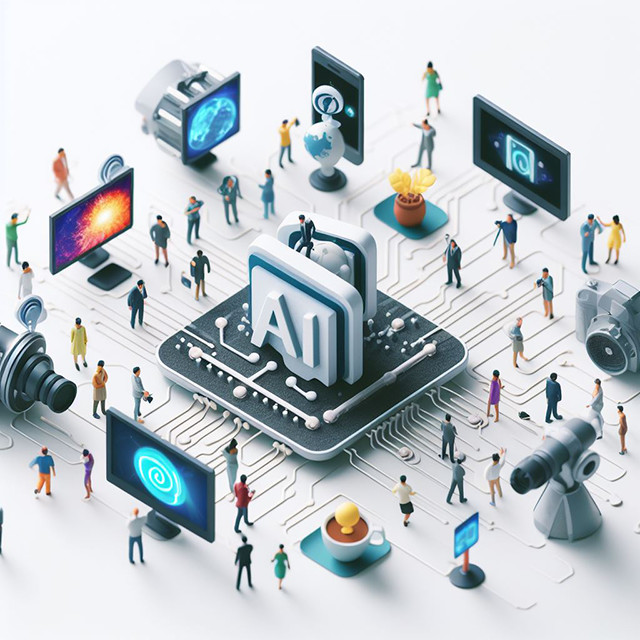How to Harness the Creative Power of Large Language Models
In our modern digital world, creativity is more important than ever. As artificial intelligence and automation take over routine tasks, we humans need to focus on bringing imagination and inspiration to our work. This is where large language models (LLMs) can help. LLMs are a type of artificial intelligence system that have been pre-trained on huge datasets of text data. This allows them to generate remarkably human-like text and engage in detailed conversations. With the right prompting and guidance, LLMs like GPT-3, among other examples, can be harnessed to enhance human creativity in amazing ways.
In this article, we'll explore what LLMs are, look at examples of their creative potential, and provide a step-by-step guide to using them to generate creative content. We'll also highlight how Barcelona in particular taps into the creative power of LLMs thanks to a long history of artistry and innovation. Read on to learn how you can spark your own creativity, whether you're based in Barcelona or anywhere else in the world.
What are Large Language Models?
Let's start by understanding what large language models are and what makes them special. LLMs are a type of natural language processing system that uses deep learning to analyze massive datasets of text. They develop an advanced understanding of how human language works and the relationships between words. Well-known examples of LLMs include OpenAI's GPT-3, Google's LaMDA and Anthropic's Claude.
LLMs are "large" because they have been trained on huge datasets - we're talking hundreds of billions of words. They ingest written text from all over the internet - everything from websites to books to social media posts. This exposes them to the nuances and complexities of human language, not without rising copyright concerns, allowing them to generate remarkably eloquent, creative text.
The key benefit of LLMs is that they are "few-shot learners". This means they can apply knowledge from their training to new contexts and tasks with very little additional data. For example, with just a few sample sentences, an LLM could learn to generate recipes or poetry. This adaptability makes them exceptionally useful creative tools.
Unlike task-specific AI like chatbots, LLMs have much broader skills. Their foundation of understanding language means they can seamlessly converse, summarize, translate, compose and more. We're really just scratching the surface of what they're capable of, especially when guided by human imagination.
Examples of LLMs' Creative Potential
To better understand the creative possibilities of LLMs, let's look at some real-world examples:
- Poetry - LLMs like GPT-3 can generate original poems in any style provided to them. Give them a few stanzas of Shakespeare, and they'll continue the verse in Shakespearean English. Show them haikus, and they'll create haikus. Their poetic skills are incredibly versatile.
- Songwriting - Musicians have used LLMs to auto-generate lyrics by feeding them examples of their previous songs. The lyrics often require polishing by humans, but contain novel metaphors and wordplay.
- Naming - Companies have used LLMs to brainstorm creative names for products by describing the product and having the LLM suggest suitable names. The names are often catchy and evocative.
- Advertising/marketing - Given some sample text in a certain tone or style, LLMs can generate slogans, taglines, ad copy, etc. This helps human copywriters get unstuck and explore more possibilities faster.
- Fiction - Aspiring authors have used LLMs to create characters, compose scenes, and add plot twists by providing the LLM a story prompt. This assists writers in drafting stories.
- Cooking - Recipe blogs have used LLMs to generate unique recipes after training them on a database of existing recipes. The LLM recipes still require testing and refinement.
These examples demonstrate how, guided by humans, LLMs can enhance creativity in a diverse range of domains. Their capabilities grow more impressive each year.
Step-by-Step Guide to Generating Creative Content
Now let's walk through the process of actually using LLMs like GPT-3 to generate creative content:
- Gather examples - The first step is to collect at least 5-10 examples that define the style, tone, length and topic you want the LLM to emulate. For a poem, these examples could be stanzas from your favorite poets. For product names, they might be existing names in your industry. These examples get the LLM ready to produce similar output.
- Write a prompt or start from a preexisting prompt obtained online - Next, draft a short paragraph (1-2 sentences) clearly summarizing the task or providing context. For example: "Write a poem about unrequited love using the following stanzas as inspiration". The more specific the prompt, the better.
- Input to LLM - With examples and prompt ready, you can submit them to an LLM API like GPT-3. Many creative apps like Jasper and Rytr also provide user-friendly interfaces.
- Generate options - The LLM will then provide multiple pages of output options. Generate more options than you need, as you'll want to cherry pick the best parts later.
- Refine and polish - Review the LLM's outputs and pull out the most creative gems. Discard options that don't make sense or align well. Polish and refine the best parts into your final product.
- Give feedback - An important last step is to provide feedback to the LLM on which outputs were best. This further trains it for your preferences.
While simple conceptually, it takes practice to frame the prompts and examples optimally. Don't get discouraged if early results aren't great. Over time, you'll learn how to guide the LLM more effectively.
Inputting to an LLM API
Once you have gathered your examples and written a prompt, the next step is feeding them into an LLM API to generate outputs. One of the most powerful LLM currently accessible via API is OpenAI's GPT-3. GPT-3 offers both a raw API and API wrappers created by other companies to make it more user-friendly.
To use the raw OpenAI API, you need an account with them. After signing up, you get an API key. You then send HTTP requests to the API with your examples, prompt and key to generate responses. The raw API requires coding skills to integrate into an app.
Easier ways to leverage GPT-3 are through creative platforms like Jasper and Rytr. These provide intuitive graphical interfaces and templates for generating content with GPT-3.
Jasper integrates GPT-3 and allows you to input examples and prompts via its clean web interface. It offers templates for blog posts, tweets, lyrics, ads and more. You can select different levels of "creativity" and "length" for outputs. Jasper also maintains your prompt history so you can iterate and improve.
Rytr has an editor that lets you provide examples and write prompts as well as view and refine the GPT-3 outputs. It structures the process into "Learning" where you provide examples and "Writing" where you write prompts and generate content. Like Jasper, it has templates for common use cases.
Tools like these make accessing the power of LLMs like GPT-3 simple for everyday users. Think of them as creative co-pilots that handle the coding and AI complexity behind the scenes. As these interfaces improve, harnessing LLMs for creative purposes will become even more accessible.
Harnessing LLMs for Creativity in Barcelona
Barcelona is an ideal city to unlock the creative firepower of large language models. Creativity and innovation are not alien to Barcelona, from the wonderful architecture of Antoni Gaudi to the genius of pioneering chefs like Ferran Adrià. LLMs align perfectly with this experimental, boundary-pushing atmosphere.
Barcelona also boasts an expanding artificial intelligence activity. The city is home to the Barcelona Supercomputing Center, which conducts advanced AI research. Top universities like the Polytechnic University of Catalonia are pushing the frontiers of natural language processing. Major tech conferences like the Mobile World Congress now highlight AI innovation. Exciting startups are popping up in Barcelona's co-working spaces and incubators.
This combination of technical expertise and creative energy makes Barcelona fertile ground for leveraging LLMs. Entrepreneurs are tapping into the city's AI talent to build the next generation of creativity tools.
The explosion of new startups demonstrate Barcelona's potential as an LLM hotspot. But this is only the beginning. Virtually every creative field from writing to visual arts to architecture can be enhanced through collaboration between humans and creative AIs. Barcelona's local government supports this vision. Some years ago the Barcelona city council appointed its first Commissioner for Digital Innovation, Electronic Administration and Good Governance, Michael Donaldson Carbón, whose mandate covers guiding Barcelona's AI strategy. Here is one of his articles: Municipal policies for digital inclusion. Catalonia has also launched an initiative to become the main AI hub in southern Europe. In fact, Catalonia is the second European region attracting funding for Deep Tech startups!
Some final words
If you're an artist, writer, marketer, entrepreneur or anyone interested in new avenues for creativity - start experimenting with LLMs today. Arm yourself with the fundamentals in this guide, and let the AI be your muse, your co-creator. Expect missteps and roadblocks as you refine the process. But with perseverance, you may find LLMs unlocking your creative abilities in ways you never thought possible. Barcelona's diverse, thriving community is the ideal place to join this artistic adventure. The future of human creativity has arrived, and LLMs are just the beginning.



Comments
Post a Comment